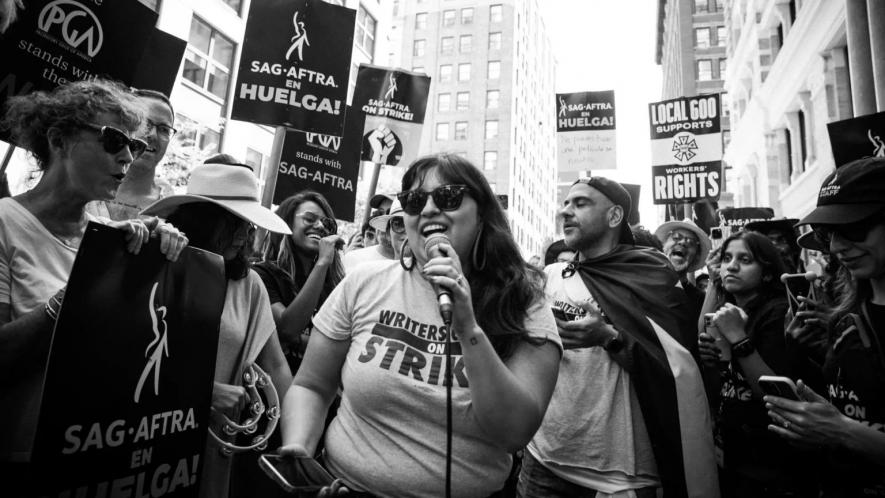Hollywood Workers are Fighting to Save Creativity in Entertainment

Striking SAG-AFTRA actors on the picket line in NYC (Photo: FJ Parsa)
248 days after the inauguration of the Hollywood writers’ strike, and 47 days after the kickoff of a similar strike by Hollywood actors, it appears that the big studios are no closer to reaching worker demands and finalizing contract negotiations.
“We accepted [the] invitation and, in good faith, met tonight, in hopes that the companies were serious about getting the industry back to work,” wrote the Writers Guild of America on August 22, in a message to union members. “Instead, on the 113th day of the strike—and while SAG-AFTRA is walking the picket lines by our side—we were met with a lecture about how good their single and only counteroffer was.” The Screen Actors Guild-American Federation of Television and Radio Artists (SAG-AFTRA) heard the same story from studios, who are represented by the Alliance of Motion Picture and Television Producers (AMPTP). On August 27, SAG-AFTRA leadership stated, “Unfortunately, as we’ve seen from the recent news out of the WGA negotiations, it appears the AMPTP is still unwilling to make the concessions necessary to make a fair deal that would bring the strikes to a close.”
Based on recent reports, it seems as if AMPTP stonewalling is part of a sinister strategy undertaken by many bosses during extended strikes: starve the workers out. As per a July 11 Deadline report, studio executives intend to “break the WGA.” “The endgame is to allow things to drag on until union members start losing their apartments and losing their houses,” one executive told the news site.
Both writers and actors are fighting to survive as the days of striking go by, with studios no more willing to return to the bargaining table than before the strike began. It’s one of the toughest positions an organised worker can be in, especially as despite enormous Hollywood profits, many of these workers live on the precipice of poverty. The minimum an actor must take home in one year to qualify for SAG-AFTRA healthcare is only USD 26,470, yet only 12.7% of members qualify. The WGA has written extensively about how compensation has not kept pace with ballooning profits.
Profit-making tools threaten to replace workers
Why keep up the fight? Writers and actors are fighting for more than just their livelihoods. They are fighting for the integrity of their craft as technological innovations such as Artificial Intelligence, controlled entirely by the studios, threaten what writers and actors have built as an artform.
SAG-AFTRA says that what AMPTP has proposed and is largely already doing to actors with AI is dystopian. According to SAG-AFTRA chief negotiator Duncan Crabtree-Ireland, “[The AMPTP] proposed that our background performers should be able to be scanned, get one day’s pay, and their companies should own that scan, their image, their likeness, and should be able to use it for the rest of eternity on any project they want, with no consent and no compensation.”
“All they have to have is just a certain number of samples and they have your image and they can recreate you in any way they want,” veteran actor Kevin Scullin told Peoples Dispatch on the picket line back in July.
SAG-AFTRA member and organiser with Anticapitalism for Artists Chris Myers told Peoples Dispatch that while AI can hypothetically be a useful tool for artists, “what the unions are mostly concerned with is how it can undercut labour itself… not just as a tool, as an aid, but as a replacement. That’s the heart of the matter.”
Consumers are unlikely to encounter major AI performances on their television screens anytime soon, but both the labour unions and the AMPTP are preparing for an uncertain future. Part of the reason the fight is so contentious now is because of how streaming technology has altered the outcomes of the current contract, principally by undercutting the amount workers are paid in residuals.
“These contracts are never about right now,” Myers said. “They’re always looking a decade or more into the future… I don’t think anybody thinks that in the next year or two we’re going to have good AI scripts, or good AI performances… I think that in ten or 15 years you might very well get decent AI scripts and decent AI performances.”
“I say decent, not good because this industry, unfortunately, hasn’t hinged on good in a very long time.”
While AI technology in the hands of corporations has the potential to replace human actors with “deepfakes,” most people in the US do not want to see AI-generated performances in TV and film. This seems to matter little to studios, who are moving forward with the technology regardless.
“I don’t think anybody’s seeing Chat GPT scripts that are better than what humans can do… I’ve seen some of the clips of AI ‘deepfake’ performances and they’re horrible. I don’t think anybody wants this except for employers who want to increase their ability to extract surplus at the point in production.”
Fighting for “human connection”
For writers, their concerns hit at a similar desire to be in control of their own creative process in the industry. “We don’t want the studio to have the ability to draft a first draft with AI and then hire a writer to come in and fix that,” Jazz Peck, writer at Monkeypaw Productions and WGA West member, told Peoples Dispatch. “Instead of having writers be paid through each step of the process and be part of the initial ideating process.”
“We’re not here to correct, we’re here to create,” they said.
Writers, like actors, are trying to get ahead of the game before AI becomes an industry standard. “We’re also working as a prevention method rather than allowing [AI] to become like the standard operation and then trying to fix it once it’s already taken a hold, because that again, allows the studio system to be the arbiter of the ways in which it’s implemented,” said Peck.
“Broadly, technology in the hands of a corporation is never as good as technology in the hands of people. And we’ve seen it happen in other industries, in factory spaces and grocery stores, gas stations, industry after industry, where things have been automated, presumably in the name of convenience.
“But is it really convenient? Is it really convenient for the for the consumer to have less interpersonal interaction and in the process, whatever process it is, whether you’re in IKEA trying to check out, or whether you’re at the movie theater and watching a movie that’s written not by the hands of a person, but by the hands of a corporation?”
AI is only a part of the overall deterioration of the artistry of the entertainment profession in the name of profit. “These companies as tech companies are not interested again in artistic productions,” said Myers. “They’re interested fundamentally in our attention. And that isn’t as simple as making the best quality artistic movie possible. It’s just what can get eyeballs on the script. So if you can use a trending content creator turned actor who acts in an AI-generated script, his performance is mostly bad. But saved through AI, it doesn’t matter as long as that gets attention. And I think that they know that and they want a contract that allows room for that.”
Peck worries about the increasing misuse of their artform to hawk products at consumers. They reference the examples of “a product like Barbie and Flamin’ Hot and Air, and all these movies about how hard it is for execs to make a product to sell to people. They’ve become glorified commercials for these things.”
“And I can only imagine what would be looming ahead if we continue to remove people from our process, versus allowing people to use tools to make it easier.”
“Film and television and artwork in general is about human connection and human commentary on culture. So when you move people from that, what does it become?”
Get the latest reports & analysis with people's perspective on Protests, movements & deep analytical videos, discussions of the current affairs in your Telegram app. Subscribe to NewsClick's Telegram channel & get Real-Time updates on stories, as they get published on our website.
























